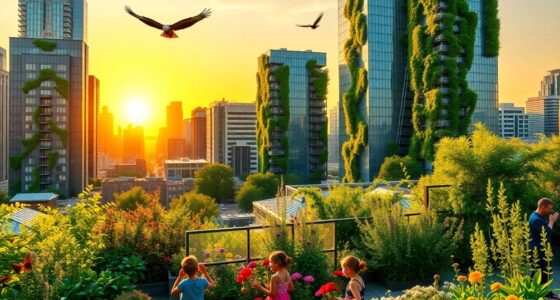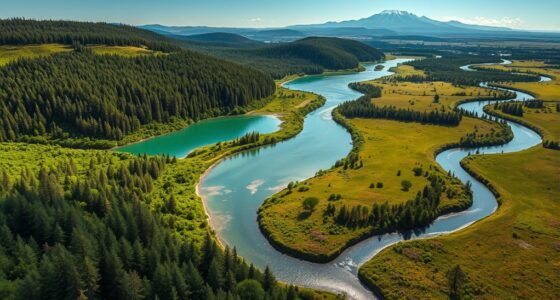Planting this one tree species can have a profound impact on our planet's future. Each mature tree absorbs about 22 kilograms of CO2 every year, helping to combat climate change and improve air quality. It also enhances local biodiversity, providing habitats for various wildlife. Importantly, its root system prevents soil erosion and manages water runoff, which can protect communities during heavy rains. By engaging in tree-planting initiatives, you also foster community bonds and promote sustainability. Curious to learn how your efforts can create a ripple effect in preserving our forests for generations to come?
Key Takeaways
- Planting a single tree enhances carbon sequestration, absorbing approximately 22 kg of CO2 annually, thus combating climate change.
- Trees provide habitats for diverse species, boosting local biodiversity and ecosystem resilience against climate change impacts.
- A mature tree significantly improves air quality by filtering pollutants, contributing to healthier urban environments.
- Tree roots prevent soil erosion and manage water runoff, protecting against flooding and maintaining soil health.
- Engaging communities in tree planting fosters environmental stewardship, empowering collective action for sustainable future forest management.
Importance of Reforestation

Reforestation is essential, as it helps restore degraded ecosystems and combat climate change. By planting trees, you can notably contribute to absorbing billions of metric tons of CO2 each year. This process not only captures carbon but also enhances biodiversity, providing habitats for countless species.
Healthy forests act as a natural buffer against soil erosion, with tree root systems stabilizing the ground and improving nutrient retention. You also play a role in regulating the water cycle, which benefits local climates and guarantees clean water for communities.
Engaging in reforestation efforts fosters a sense of environmental stewardship, supporting sustainable livelihoods for those who depend on forests. Your involvement in planting trees can spark meaningful change for our planet's future.
Benefits of Tree Diversity

Planting a variety of tree species plays a significant role in maintaining healthy ecosystems. Tree species diversity enhances ecosystem health by supporting a range of wildlife and functions, making forests more resilient to climate change, pests, and diseases. Here's how different trees contribute:
| Benefits | Description |
|---|---|
| Ecosystem Stability | Indigenous trees boost local biodiversity. |
| Climate Adaptation | Diverse forests adapt better to changes. |
| Long-term Resilience | Biodiversity reduces the risk of ecosystem collapse. |
Additionally, certain trees can provide health benefits through their unique properties, such as improving air quality and supporting local wildlife.
Causes of Deforestation

When you think about deforestation, agriculture expansion stands out as a major culprit, clearing vast areas to make way for crops and livestock.
Urbanization and infrastructure development also play a significant role, encroaching on forests and fragmenting ecosystems.
Understanding these causes is essential if we want to tackle the deforestation crisis effectively.
Agriculture Expansion Impact
Agriculture expansion poses a significant threat to global forests, as it drives approximately 80% of deforestation worldwide. The demand for crops like soy and palm oil, along with livestock grazing, leads to the destruction of ecosystems and biodiversity. Every year, about 15 billion trees are cut down to make space for agricultural land, contributing to climate change and habitat loss.
| Impact | Details |
|---|---|
| Deforestation Rate | 80% of global forest loss |
| Area Cleared | 1.3 million square kilometers |
| Livestock Contribution | 70% of Amazon deforestation |
| Tree Loss Annually | 15 billion trees |
Tree planting initiatives can help combat these effects, promoting a healthier climate and restoring essential ecosystems.
Urbanization and Infrastructure Development
As urban areas continue to expand, they encroach on natural landscapes, leading to significant deforestation. Urbanization drives this destruction, as cities consume forests for housing and infrastructure.
By 2050, around 70% of the world's population will live in urban settings, intensifying the pressure on our remaining forests.
Consider these impacts of urban sprawl:
- Habitat fragmentation displaces wildlife.
- Increased greenhouse gas emissions from construction and transportation.
- Loss of essential ecosystem services like carbon storage.
- Degradation of water filtration systems crucial for clean water.
- Reduced biodiversity, threatening many species.
You can help combat urbanization's effects by advocating for sustainable development and supporting tree planting initiatives. Implementing efficient storage strategies in urban planning can also help maximize space while preserving green areas.
Every effort counts in preserving our planet's crucial forests.
Climate Change Impact
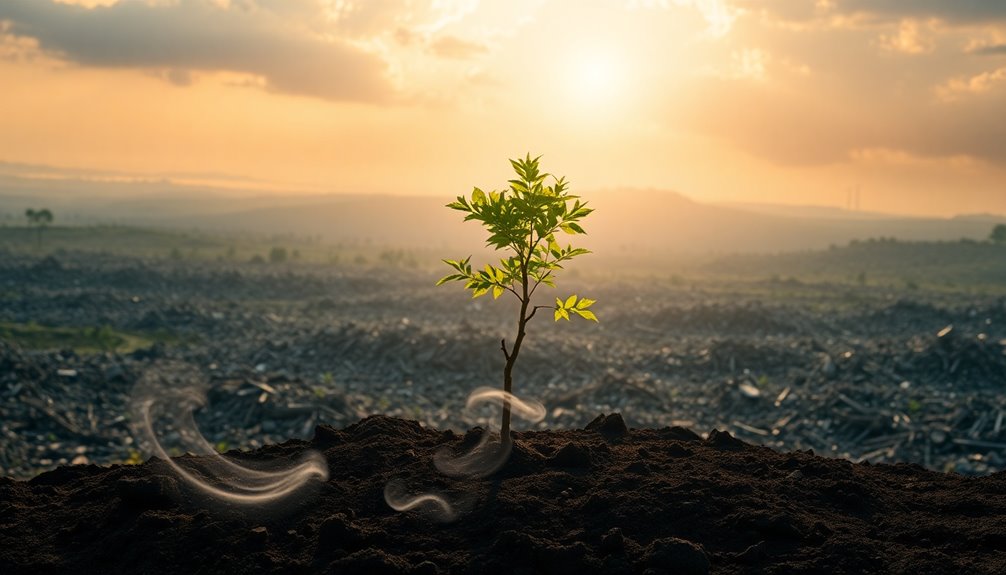
When you plant a tree, you're not just adding greenery; you're also boosting carbon sequestration, which helps reduce carbon dioxide in the atmosphere. This simple act can play a significant role in mitigating extreme weather events linked to climate change. Additionally, the transition to greener mining practices in the cryptocurrency industry could further aid in reducing our overall carbon footprint.
Carbon Sequestration Benefits
Planting trees offers significant carbon sequestration benefits, especially in the fight against climate change. By absorbing carbon dioxide, trees play a crucial role in reducing atmospheric CO2 levels.
Here are some key points to reflect on:
- One mature tree absorbs about 22 kg of CO2 annually.
- A 40-year-old tree can trap around one tonne of carbon.
- An acre of trees can provide enough oxygen for 18 people each year.
- Trees act as natural sponges, filtering pollutants from soil and air.
- Global forest loss could release 3.5 to 4.2 billion metric tons of greenhouse gases annually.
- Additionally, energy-efficient technology in heating and cooling systems can further enhance the sustainability efforts associated with tree planting.
Mitigating Extreme Weather
Trees are essential in mitigating extreme weather, especially as climate change intensifies its effects. By stabilizing soil, they help prevent landslides and floods in areas with heavy rainfall. A single mature tree can absorb 1,500 to 2,000 liters of water each year, markedly cutting the risk of flash floods in urban settings.
Furthermore, urban forests with at least 40% canopy coverage can lower city temperatures by up to 25°F, combating the urban heat island effect. Deforestation, on the other hand, increases temperatures and alters precipitation, leading to more severe weather events. Additionally, trees contribute to a healthier environment by reducing carbon emissions and improving air quality, which is vital for combating climate change.
Role in Flood Prevention

The remarkable role of trees in flood prevention can't be overstated. By planting this one tree, you can greatly enhance flood management in your community. Mature trees absorb between 1,500 to 2,000 liters of water annually, which helps stabilize soil and promotes water infiltration.
Here are some key benefits of increased tree cover:
- Reduces surface runoff during heavy rainfall
- Prevents soil erosion with strong root systems
- Enhances water retention for better flood prevention
- Decreases flooding incidents in urban areas
- Keeps waterways cleaner and healthier
Incorporating trees into urban planning is essential.
The more trees you plant, the better you manage stormwater and protect your community from the devastating impacts of floods.
Mental Health and Wellbeing

Enhancing your community's resilience against floods isn't just about managing water; it's also about fostering a healthier environment for everyone. By planting trees, you can transform your neighborhood into a green oasis that greatly boosts mental health.
Studies show that spending time around trees lowers blood pressure and alleviates stress, leading to improved emotional wellbeing. Urban trees provide essential shade and recreational spaces, enhancing life satisfaction for all residents.
In addition, exposure to nature, including views of trees, can elevate your mood and reduce anxiety. Interacting with these natural elements can even sharpen cognitive function and creativity. Furthermore, incorporating aromatherapy techniques can further enhance relaxation and reduce anxiety symptoms in community spaces.
Community Engagement Strategies
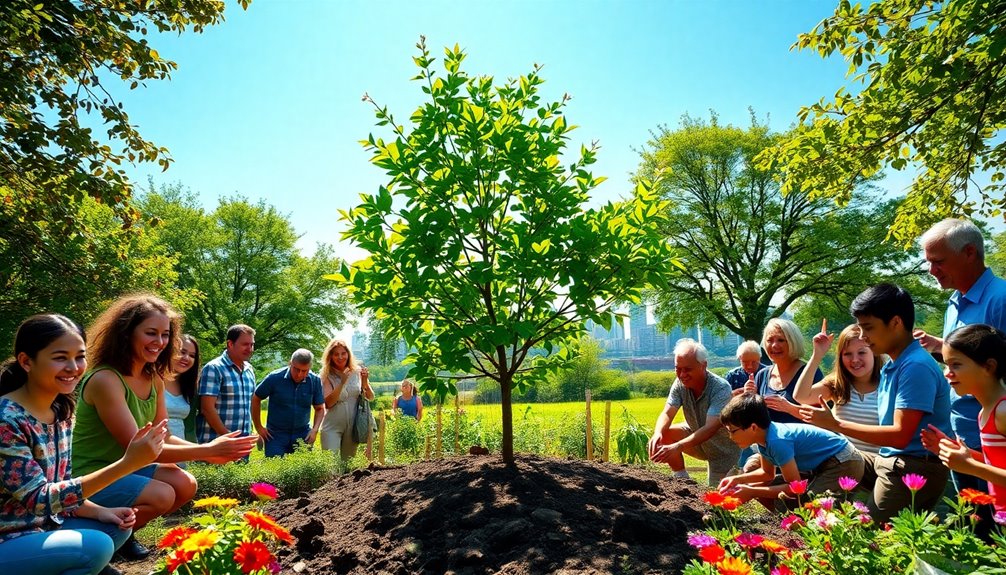
How can you effectively engage your community in tree planting initiatives? Start by fostering a sense of ownership and responsibility. Here are some strategies to contemplate:
- Host educational workshops to inform community members about the benefits of trees.
- Collaborate with local businesses to secure funding and resources for your projects.
- Include indigenous communities to leverage their knowledge of native species and ecological practices.
- Organize community-led tree planting events to enhance social bonding and environmental awareness.
- Create a volunteer program that encourages ongoing participation in local conservation efforts. Additionally, fostering emotional regulation through community activities can enhance participants' overall well-being and social connections.
Ongoing Research Initiatives
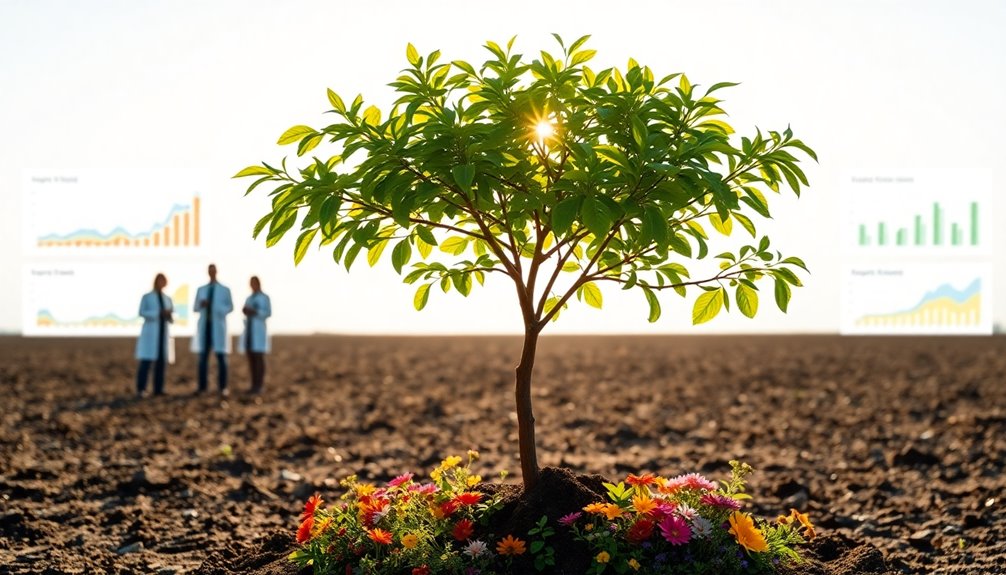
Engaging the community in tree planting initiatives sets the stage for deeper involvement in ongoing research initiatives that can further enhance your local environment.
Organizations like Earthwatch invite volunteers to participate in scientific expeditions focused on climate change solutions through forest ecology. These initiatives study the long-term effects of reforestation and tree planting on ecosystem health and carbon sequestration, particularly in areas like the Peruvian Amazon.
By collaborating with local communities, scientists drive effective forest management and restoration policies based on these research findings. Additionally, blogs and newsletters share valuable insights, fostering public engagement and awareness about conservation efforts.
Your participation not only aids essential research but also empowers your community to take action for a sustainable future.
The Future of Our Forests
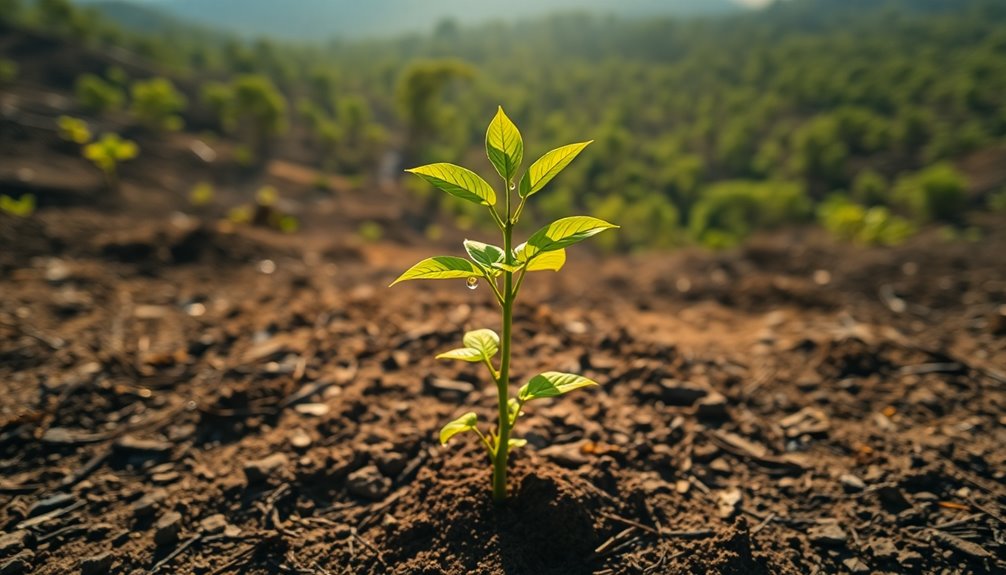
As we look toward the future of our forests, it's clear that their preservation is essential not only for the environment but also for the livelihoods of countless individuals.
By prioritizing forest restoration, we can boost carbon capture and safeguard biodiversity. Consider these points:
- Forests house around 60,000 tree species, supporting over 80% of terrestrial biodiversity.
- Each year, over 15 billion trees are cut down, causing habitat loss and increased greenhouse gases.
- Restoring degraded forests can sequester a third of the carbon needed to mitigate climate change.
- Healthy forests provide clean water and essential resources for those in extreme poverty.
- Initiatives like the 1t.org aim to engage communities in sustainable practices for long-term ecological benefits.
The future of our forests depends on our actions today.
Frequently Asked Questions
How Does Planting a Tree Help the Earth?
Planting a tree helps the Earth in numerous ways. It absorbs carbon dioxide, reducing greenhouse gases and combating climate change.
A tree stabilizes soil and absorbs water, preventing floods and supporting local water cycles. Each tree generates oxygen, enough for four people, and filters pollutants, promoting cleaner waterways.
Plus, it provides habitats for countless species, enhancing biodiversity and supporting ecosystems.
What Is the Power of One Tree?
Imagine a single tree standing tall, its branches stretching like arms welcoming the sun.
That one tree has the power to absorb 22 kilograms of carbon dioxide each year, breathing life into our planet. It produces enough oxygen for four people daily, cools urban heat, and prevents soil erosion.
Why Can Planting Trees Help Global Climate Change?
Planting trees helps global climate change because they absorb carbon dioxide, a major greenhouse gas. By sequestering significant amounts of carbon over their lifetimes, trees directly combat rising CO2 levels.
Additionally, reforestation restores ecosystems, boosting biodiversity and creating habitats essential for wildlife. When you plant trees, you contribute to a healthier planet, enhancing resilience against climate impacts and supporting efforts to reduce fossil fuel reliance, making a tangible difference in the fight against climate change.
What Is the Greek Proverb About Planting Trees?
The Greek proverb "A society grows great when people plant trees whose shade they know they'll never sit in" highlights the importance of selflessness and future-oriented actions.
It emphasizes that planting trees is an investment in the wellbeing of future generations, even if you won't benefit directly.
Conclusion
You might think that planting just one tree won't make a difference, but every single tree contributes to a healthier planet. By taking action, you're part of a larger movement that fights climate change, supports biodiversity, and enhances mental well-being. Plus, you inspire others in your community to join in. Imagine a future where vibrant forests thrive, flood risks diminish, and people reconnect with nature. Your choice to plant today can shape a brighter tomorrow for everyone.


